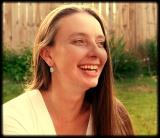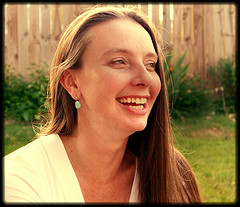Creative Writing in a Chemotherapy Infusion Center
 If it’s Wednesday, you won’t find me in my office, not at my desk at home nor the one at work. You won’t find me at the quirky Blue Moose Café, or The Grind just off campus, indulging in reading and writing with a healthy dose of caffeine. You won’t find me in the Robinson Reading Room of the Wise Library at West Virginia University. Instead, you might find me riding the Personal Rapid Transit, or PRT, a monorail that connects the various WVU campuses around Morgantown, traveling from downtown to the Health Science Center. When the doors open at the depot, you might find me climbing stairs and walking across the parking lot towards the Mary Babb Randolph Cancer Institute, making my way to the second floor of the building, to the chemotherapy infusion center. It’s here that I spend Wednesdays, working with patients with cancer, although I’m not a doctor or a nurse. I’m a creative writer. Instead of taking a patient’s vitals, I’m there to take his or her story.
If it’s Wednesday, you won’t find me in my office, not at my desk at home nor the one at work. You won’t find me at the quirky Blue Moose Café, or The Grind just off campus, indulging in reading and writing with a healthy dose of caffeine. You won’t find me in the Robinson Reading Room of the Wise Library at West Virginia University. Instead, you might find me riding the Personal Rapid Transit, or PRT, a monorail that connects the various WVU campuses around Morgantown, traveling from downtown to the Health Science Center. When the doors open at the depot, you might find me climbing stairs and walking across the parking lot towards the Mary Babb Randolph Cancer Institute, making my way to the second floor of the building, to the chemotherapy infusion center. It’s here that I spend Wednesdays, working with patients with cancer, although I’m not a doctor or a nurse. I’m a creative writer. Instead of taking a patient’s vitals, I’m there to take his or her story.
The chemotherapy infusion center is a large box; the outside of the box is lined with cubbies, with three walls and a curtain that slides across for some additional privacy. The box’s center contains nurses stations, computers that can be wheeled around to cubbies, The kind of instruments and gear you’d expect to see in a bustling clinic. When I arrive I check in with the charge nurse. She’ll direct me to patients who I might have deliveries for—deliveries not of flowers or lunch but of stories—and or direct me to new patients to work with. New patients, new stories.
In October 2015, I met with Dr. Carl Grey. Carl, a young doctor, has a compact, athletic build, blonde hair, thick glasses and a shy smile. He married a woman I knew from grad school who runs the literary imprint of the WVU Press. In my mind, this makes them a power couple. Carl had a clever idea—that patients would be more open to tough conversations with their physicians if those patients had reflected on their lives and values first, and doctors could know those lives and values through expressive writing. But he wasn’t sure how to get started.
I’d worked with a dying man, about a year before, helping him craft a memoir. During this time I learned about narrative medicine, and attended workshops run by Rita Charon, MD, PhD. I like to call her St. Rita, because I find her work a miracle. St. Rita believes stories matter, and that the care of sick unfolds in stories. She believes that through these stories we bear witness to lives, and through writing and reading we join in attention, representation and affiliation in ways that make order from chaos. Through my work writing with patients with cancer, I find my view in line with hers. In the chemotherapy infusion center, I get some of those stories, the stories of the patients. I don’t ask about their cancer explicitly, but of course the patients can talk about that if they want. In West Virginia, where I live and work, patients like to talk about work, food, and family. I can’t tell you how many stories include parts of recipes and the food eaten at family events—from barbecue to soup beans, fried chicken to Hawaiian meatballs. Gardens, too. Tomatoes, squash, beans, lettuce, you name it. In West Virginia, telling a good story is considered an art of its own.
My storytelling patients range from late teens to over 80 years old. They are all receiving chemotherapy for some kind of cancer, some in early stage, others progressed. Not all, but most are Appalachian, many natives of West Virginia who still live here.
Part of the reason I’ve talked in summary about the patient stories is that, under our project, they’re protected by HIPAA. That allows the patient to be in control of their story. We do survey them to see where they end up. Most are shared with family members and friends.
To get a patient story, I sit with each, working through a release form and some surveys. One survey collects quality of life information and another collects demographic data. Both will be logged in a secure database so we can analyze the results later. We have a study group and a control group. The study group begins the storytelling immediately, while control group does the story portion at a later date. I’d never thought of writing in these terms before, and it’s interesting learning this world of research. I go through guided questions to get at stories and while I do this I record the conversation. Later, this recording is worked up into a transcript, and from that transcript I work on a first-person account. When I have the story ready, I bring it to the patient in a crisp blue folder. Patients read through and can make any edits they need or want to make. When their story is finished, it’s theirs to keep and share. Most of the patients I work with have never thought to write anything down about their lives, and when I bring their stories, they get excited to read them. One patient, having a tough day in the clinic, actually went from slumped and ashen looking to sitting up, with brightness in his eyes. Carl has often said the stories turned out more beautifully that he imagined. We do file a copy for the study, and he reads every one.
Carl and I worked for about six months on grants to help make this project a reality. There have been plenty of supporters, and just as many naysayers. We forged on through the conviction of our belief and a lot of long arduous days writing and revising grant proposals. It pays off: of the first group of patients we’ve worked with, about 20% have been referred for symptom management or participated in Advance Care Planning because of the story project. Advance Care Planning is a set of directives patients create so that their wishes for their care are carried out if they are unable to speak for themselves. It shows one way the arts can have a palpable affect in a life, and how humanities and STEM are better together than in competition. The stories actually lead to improved care.
I like to think I might help change health care for the better. I am a rheumatoid arthritis patient, a condition that cut short my progress as a ballet dancer. Writing became a way to deal with that loss, and to forge a new identity. My younger brother is a cancer patient. Diagnosed young, cancer wasn’t just a shock to him but our whole family. Writing has helped me be a better caregiver and sister to him. My brother shares in the excitement about the ways in which writing life stories might better the relationship between doctors and patients.
Our writing in the cancer institute is a two-year pilot project. I don’t know what will come at the end of that time. I hope I’ll be able to do more work like the writing I do with patients with cancer. I feel touched, honored, and blessed to work with them. Most of all, I feel humbled. I find myself the caretaker of stories, and it’s an important job.
Because of this project, a group of patients with cancer will have a part of their life on the page. What I wish and hope is that these stories are meaningful artifacts for these patients and their families. For my share, the process of making the stories creates meaning for me, and buoys my faith in all the good things that writing can do. I’ve been asked if I get depressed going to work in the infusion center, but truth told, Wednesdays are the best day of my week. I know patients don’t wish to be in the infusion center. Maybe the making of these stories makes their time in the infusion center a little bit better.
My work infuses me with hope, spreading through me as if through an IV. A great hope is that more creative writers might have opportunities to do this kind of work. There are many programs people can attend—from the workshops and Masters program at Columbia University, under St. Rita, to more humble workshops, like the one I’m adding to the annual West Virginia Writers’ Workshop. Learning about how others write with patients can lead to new projects and initiatives. I recently learned about the Art for Healing at Yale New Haven Hospital’s Children’s, a program that integrates many art forms in support of healing. There are many, many more. We need to harness this collective power of art and healing. Writing can be a way to personal fulfillment, but writing can also be in service to others. This is one small way. If we have enough small ways, we have something big, changing way we live in the world, word by word, story by story. If we can do it in the heart of Appalachia, where, it seems, nothing comes easy, then I think we can spread it to all the places where people look for care. St. Rita says, “Stories matter.” Believe her.
